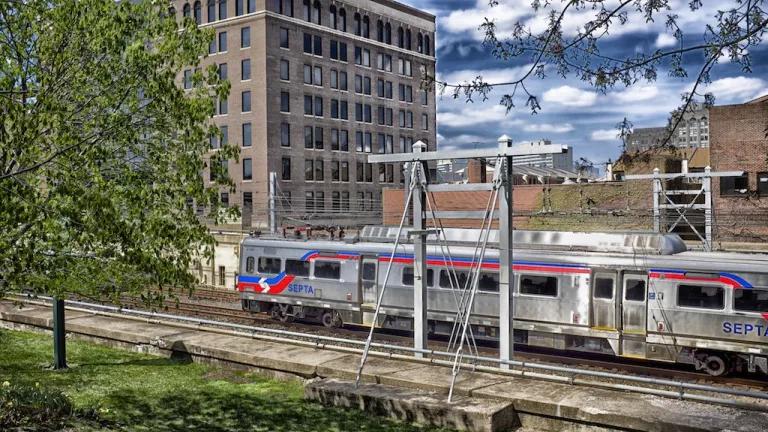Clean Cars Yield $157 Billion in Benefits for Pennsylvanians
A new study shows that the Advanced Clean Cars II Program can bring $157 billion in benefits to Pennsylvania.

Dennis Schroeder/NREL, 26765
Pennsylvania has an important opportunity to provide significant air quality, health, and economic benefits to its residents by adopting the Advanced Clean Cars II (ACC II) standard.
Under this standard, manufacturers will sell increasingly higher percentages of new zero-emission vehicles (ZEVs) in each model year (MY), starting with 43 percent new ZEV sales in MY 2027. Under a full ACC II rule, auto manufacturers will need to sell 100% new ZEVs by MY 2035. Under ACC II, ZEVs include battery electric vehicles, plug-in hybrid electric vehicles, and fuel cell electric vehicles.
A new analysis from ERM, commissioned by the NRDC (Natural Resources Defense Council), and the Union of Concerned Scientists (UCS), shows the significant potential public health, environmental, and economic benefits that adopting the full ACC II program could bring to Pennsylvania under different scenarios.
Policy Scenarios
The report evaluated the following scenarios:
- Baseline: All new light-duty vehicles sold in Pennsylvania continue to meet existing vehicle standards. ZEV sales increase but are capped at one-third of new vehicle sales each year.
- ACC II Flex: Pennsylvania starts implementing ACC II in MY 2027, and vehicle manufacturers use many of the available compliance flexibilities such that they sell fewer ZEVs than is nominally required by the regulation.
- ACC II Flex + Clean Grid: Pennsylvania starts implementing ACC II in MY 2027 and reaches 100% clean electricity generation by 2040. Manufacturers use many of the available compliance flexibilities.
- ACC II Full + Clean Grid: Pennsylvania starts implementing ACC II in MY 2027 and reaches 100% clean electricity generation by 2040. Manufacturers do not use any of the compliance flexibilities.
Public Health and the Environment
Compared to the Baseline scenario, by 2050 the ACC II scenarios with a clean grid are estimated to reduce annual LDV fleet NOx emissions by 97% and PM emissions by 95%. The impact on Pennsylvania residents cannot be understated. This would deliver much cleaner air and better health for all residents: The resulting cumulative public health benefits for all scenarios between 2027 and 2050 include 288 to 432 fewer premature deaths, 269 to 404 fewer hospital visits, and 160,752 to 226,197 fewer minor cases of illness. The value of these public health benefits totals between $3.8 billion and $5.7 billion.
Compared to the Baseline scenario, under the ACC II scenarios cumulative greenhouse gas (GHG) emission reductions from Pennsylvania’s light-duty fleet reach between 202 and 367 million metric tons of CO2e from 2027 through 2050. The benefits of these GHG emissions reductions are valued at $17.7 billion to $31.8 billion.
Economic Impacts
By the time ACC II is launched, in MY 2027, the average light-duty ZEV in Pennsylvania will save its owner approximately $19,000 in lifetime costs compared to a conventional vehicle.
Drivers purchasing a ZEV in MY 2030 or after could save up to $20,500 in lifetime costs.
For rural Pennsylvanians, who are assumed to prefer a longer-range ZEV with higher up-front costs, an MY 2027 ZEV will save its owner $10,100 over its lifetime compared to a gasoline vehicle, and for an MY 2030 ZEV, lifetime costs will be about $18,100 lower. Rural drivers of ZEVs purchased after MY 2030 will enjoy total savings of more than $22,000.
Under the ACC II Flex scenarios, annual net utility revenue from light-duty electric vehicle charging is projected to be $66 million in 2030, $737 million in 2040, and over $1 billion in 2050.
The ACC II Full + Clean Grid scenario more than doubles net utility revenue in 2030 to $117 million, with $767 million in revenue in 2040, and over $1 billion in 2050.
Since ACC II will likely increase utility net revenue as it electrifies Pennsylvania’s LDV fleet, Pennsylvania’s average residential and commercial rates could be 5.4 percent lower by 2050. The average Pennsylvania household could therefore save $180 each year on its electricity bill, and the average commercial customer $895 each year.
The deployment of ZEV charging infrastructure will also bring substantial investments to the state. Implementing ACC II will require up to 4.7 million in-use charge plugs. Purchasing and installing these chargers will bring approximately $12 billion in cumulative investment by 2050.
Adopting ACC II will result in a net increase of more than 3,500 jobs nationally by 2050. Average wages for the new jobs created are expected to be about 50 percent higher than average wages for the jobs that will be replaced.
Conclusion
Taken together, the cumulative net societal benefits by 2050 reach $136 billion under the ACC II Flex scenario, $150 billion under the ACC II Flex + Clean Grid scenario, and $157 billion under the ACC II Full + Clean Grid scenario.
To fully capture the most benefits, Pennsylvania must adopt ACC II before the end of this year so that it is implemented starting in MY 2027. This way, Pennsylvanians can fully receive the significant public health, climate, and economic benefits as the state transitions to a clean transportation system.



